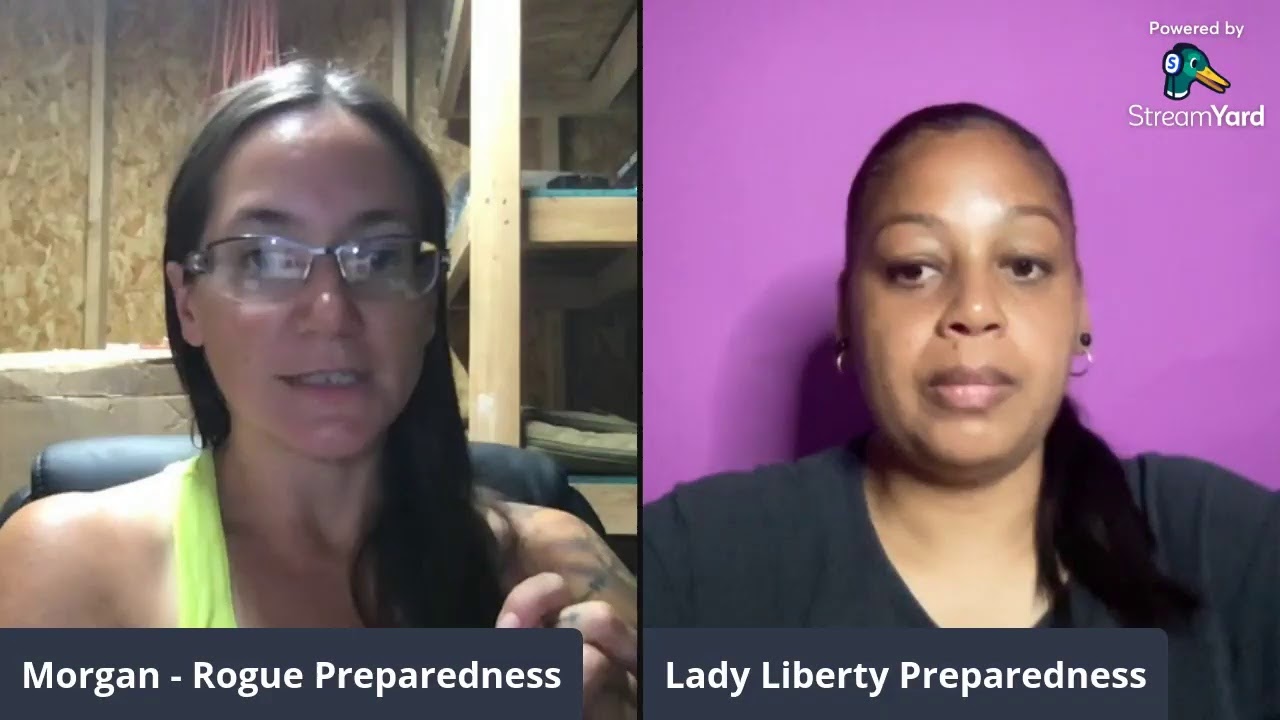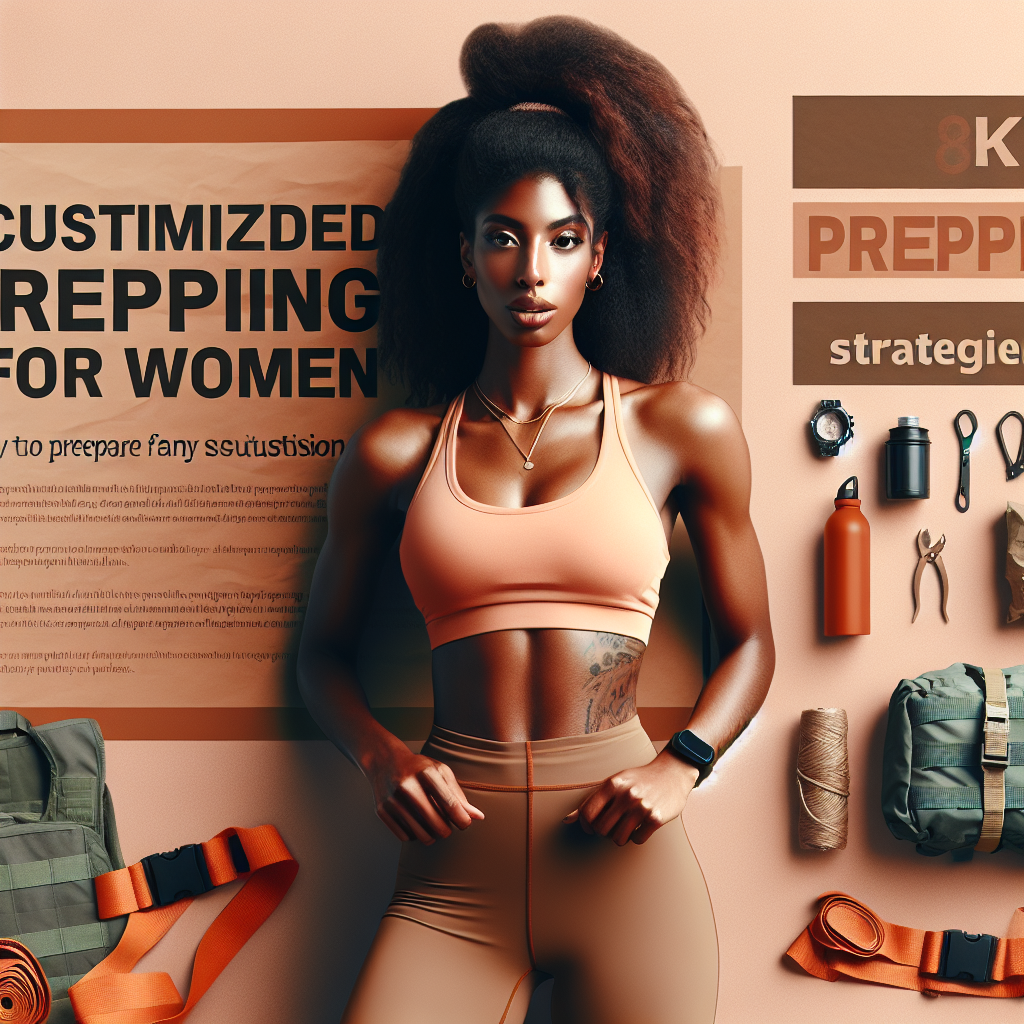Womens Preparedness
How to Figure Out What to Prep with Lady Liberty Preparedness

Today’s livestream talks about how to figure out what to prep next or focus on at any given moment.
source
Womens Preparedness
Customized Prepping Strategies for Women: How to Prepare for Any Situation

Hello ladies! I’m Jade Tripp, your friendly neighborhood advocate for women’s self-defense, personal protection, and preparedness. In a world that can sometimes feel unpredictable, it’s crucial for us to empower ourselves with knowledge and strategies that fit our unique needs and lifestyles. Today, we’re going to dive into customized prepping strategies for women, ensuring you feel confident and prepared for whatever life throws your way.
Understanding Your Personal Risks
The first step in preparation is understanding the risks that may be more prevalent for women. For instance, statistics show that women are at a higher risk for certain types of violence, including domestic violence and sexual assault. Taking this into account will guide your prepping.
Examples:
- Urban Environments: If you live in a city, consider potential dangers such as theft or harassment.
- Rural Areas: Women in these areas may need to focus more on self-sustenance and emergency preparedness due to longer response times from emergency services.
Creating Your Personalized Emergency Plan
Every woman’s life is unique, and your emergency plan should reflect that. Consider the specific challenges you may face in your daily life and customize your preparation accordingly.
Key Components of Your Plan:
-
Evacuation Routes: Familiarize yourself with multiple routes in your area, especially if you frequently travel on foot or by public transport. Use apps like Google Maps to create an offline version for times when service might be down.
-
Safe Meeting Places: Designate a few locations where you can regroup with friends or family in case of an emergency. It could be a local café, a library, or a park.
- Communication Plan: Set up a plan for keeping in touch with loved ones. Apps like WhatsApp and Signal can allow for secure communication even if traditional networks go down.
Real-Life Example:
Consider the 2017 hurricanes in Texas, where families were separated during evacuations. Many learned the importance of having an agreed-upon rendezvous point. One woman, a Houston native, shared how her family stayed connected through family group texts and chose a local high school gym as their meeting point.
Building Your Personal Safety Toolkit
Having a safety toolkit is crucial for every woman. This toolkit might look different for each of us based on our comfort levels and lifestyles. It should include both physical self-defense items and mental strategies.
Essential Items:
-
Pepper Spray or Personal Alarm: Programs like R.A.D. (Rape Aggression Defense) often recommend these items for emergency situations. Many municipalities and universities provide courses for women to practice their self-defense skills.
-
First Aid Kit: Customize your first aid kit to fit your specific needs. Include items like personal medications and feminine hygiene products, as these are often overlooked in standard kits.
- Self-Defense Skills: Consider enrolling in a women’s self-defense course. Learning techniques can boost your confidence and prepare you for unforeseen circumstances. Local martial arts studios often offer these classes specifically tailored for women.
Inspiration from Real Women:
Take inspiration from Kelly Herron, a runner who fought back against an attacker in a restroom. She used her voice, awareness, and a small tactical pen as a self-defense tool against her assailant. Kelly survived and now advocates for self-defense training for women, emphasizing that being prepared isn’t just about tools; it’s about mindset.
Community Support: A Critical Element
No woman is an island! Engaging with your community is vital for successful prepping. Connect with other women who share your interests in safety and preparedness, forming a supportive network.
How to Build Your Community:
-
Local Workshops: Participate in workshops on personal safety, emergency preparedness, or even gardening for sustainability. Local libraries or community centers often host free or low-cost events.
-
Online Forums: Platforms like Facebook Groups or Reddit have communities dedicated to prepping, safety, and self-defense where you can share experiences and gather tips. Connect with other women to share resources, advice, and support.
- Join a Group: Consider joining a local chapter of organizations focused on women’s safety and self-defense. The Zonta Club, for instance, empowers women through various initiatives and can help you find like-minded individuals.
Constantly Reevaluate Your Strategies
Prepping is not a one-and-done scenario; it’s an ongoing process. Take time each season to reflect on your strategies. Are they still relevant? Have any life changes impacted your needs?
Seasonal Checks:
- Assess your gear, ensuring it’s in good condition.
- Update your emergency contacts and communication plans based on recent changes in your social circle or locality.
- Consider any new local risks—natural disasters, urban developments, etc.—that might require you to adjust your strategies.
Conclusion: Empower Yourself
When we take charge of our safety and preparedness, we not only empower ourselves but also inspire other women to do the same. Remember that prepping isn’t about paranoia; it’s about being proactive and confident in your abilities.
Feel free to share your own experiences, tips, or questions in the comments! This is a journey we can share, and together, we can cultivate a community of women who are not just prepared but thrive in every situation. Let’s stay safe, strong, and empowered, ladies!
Womens Preparedness
From Instinct to Action: How Intuitive Safety Habits Keep You Safe

From Instinct to Action: How Intuitive Safety Habits Keep You Safe
Hello, ladies! I’m Jade Tripp, and today I want to dive into a topic that’s essential for every woman—how our instincts can transform into actionable habits that will keep us safe. In our fast-paced, ever-evolving world, understanding and harnessing our intuitive insights is more important than ever. Let’s talk about how we can refine our instincts and turn them into reliable safety habits that empower us.
Trusting Your Instincts
Our instincts are powerful; they’re shaped by years of experiences, observations, and even evolutionary biology. Consider a real-life scenario: Jennifer, a mother of two, was walking to her car late one evening. She noticed an unfamiliar man lingering too close to the entrance. Something about his demeanor didn’t feel right. Instead of dismissing her feelings, she took a moment, looked around for others, and opted to walk back inside the building to ask for help. Trusting her gut prevented a potentially dangerous situation!
Developing Intuitive Habits
-
Awareness and Environment Scanning
Make it a habit to scan your surroundings. Whether you’re in a bustling street or a quiet park, stay aware of the people around you. Try the “3-6-9” method: every three minutes, glance at your surroundings; every six minutes, take note of any changes; and every nine minutes, assess any potential threats. Pay attention to how you feel in different settings and take note of anything that feels off.
-
Body Language Reading
Your instincts can enhance your ability to read body language. Observing someone’s posture and movements can provide clues about their intentions. For instance, if you see someone approaching with a closed-off stance, like crossed arms, that might signal they’re not coming in peace. Understanding these cues can be instrumental in assessing situations early.
-
Practice Situational Awareness
Engage in drills that enhance your alertness. For example, try attending a women’s self-defense class, such as those offered by organizations like R.A.D. (Rape Aggression Defense Systems). Not only will you learn vital skills, but you’ll also sharpen your awareness and responses to potential threats, turning instinct into action.
- Create a Safety Plan
Just like we prepare for a rainy day, having a personal safety plan is crucial. Discuss safety routes and check-in points with family or friends. For example, when Emily goes hiking, she always makes sure to tell her partner when and where she’ll be. She also carries a small pepper spray and knows the nearest exit points along her path. This preparation gives her peace of mind and the ability to act swiftly if needed.
Embracing Technology
In this digital age, there are tools at our disposal to enhance our safety. Consider apps like “SafeTrek” or “Noonlight,” which allow you to notify authorities with the press of a button if you feel threatened. Practicing how to use these apps can be an intuitive habit that seamlessly combines technology with instinctual safety awareness.
Building a Community of Support
We can’t underestimate the power of a supportive community. Each time a woman shares her safety tips, experiences, or drills with her friends, she’s building a network of resilience. Think of local workshops or community gatherings that focus on women’s safety, like those hosted by organizations such as Girl Scouts or local women’s shelters. The more we share knowledge, the stronger our community becomes.
Real-Life Inspiration
Let’s get inspired by women who turned their instincts into action. Malala Yousafzai famously said, “When the whole world is silent, even one voice becomes powerful.” She trusted her instinct to speak out against injustice, even in the face of danger. Similarly, police officer Karen Stout realized the importance of empowerment when she introduced self-defense workshops in her community—targeting not just physical skills, but also the art of intuition.
Final Thoughts
It’s crucial to remember that we all have innate survival instincts; it’s what makes us human. By acknowledging them, practicing intuitive safety habits, and creating a supportive community, we can turn those instincts into actionable measures that keep us safe.
So, dear sisters, let’s regularly check in with ourselves and each other. Let’s commit to honing our instincts, developing intuitive habits, and fostering a strong, safe community. The world can be unpredictable, but with instinct and preparation working hand in hand, we can navigate it with confidence.
Stay safe and empowered,
Jade Tripp
Womens Preparedness
Empowering women through birth preparedness and complication readiness

Maternal health risks shouldn’t depend on where you live. In Burkina Faso, pregnant women face high risks—but Enfants du …
source
-

 Womens Self Defense10 months ago
Womens Self Defense10 months agoNew Legislation Empowers Women to Defend Themselves
-

 Self Defense News1 year ago
Self Defense News1 year agoShe was convicted of killing her abusive boyfriend. Now a Maple Grove woman is home awaiting a new trial.
-

 Self Defense News1 year ago
Self Defense News1 year agoSelf-Defense for All: The new Gracie Jiu-Jitsu Pasadena is for everyone | Online Features
-

 Womens Self Defense1 year ago
Womens Self Defense1 year agoTop 5 Self-Defense Techniques Every Woman Should Know
-

 Womens Fitness1 year ago
Womens Fitness1 year agoXtreme Bodyweight HIIT (Lots of Jumping!) | Joanna Soh (Fio Series)
-

 Womens Self Defense7 months ago
Womens Self Defense7 months agoUnderstanding State-by-State Variation in Self Defense Laws
-

 Womens Preparedness1 year ago
Womens Preparedness1 year agoThe Importance of Self-Sufficiency Skills in Today’s World
-

 Womens Preparedness1 year ago
Womens Preparedness1 year ago10 essential skills for surviving in the great outdoors

